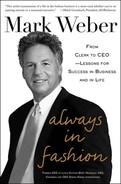 15
15 
Maybe Twice in My Career I Was Brilliant
At 34 years old, I was divisional president of the Van Heusen Company. I had always been involved in the marketing of the companies and the brands I worked with, but now I was responsible for advertising all the brands in the company. As a young man, I learned from our head of advertising and one of my great collaborators, Henry Justus, that “the number one rule of marketing and advertising is to break through the clutter.” The other important idea I’ve always kept in mind is paraphrased from the legendary retailer John Wanamaker: I know 50 percent of my advertising works; I just don’t know which 50 percent.
Marketing is the sum total of everything you do to build your brands. Everyone who has a product is constantly thinking, What can I do to make my brand more important? What can I do to make my brand more valuable? What can I do to make my brand demand a higher price point? What can I do to make sure my brand lasts the test of time? What can I do to make sure my brand is the chosen brand against my competitor? How do I make sure I don’t wake up one day and be irrelevant? These are the things marketers worry about.
Successful marketing depends on understanding your customers. At Phillips-Van Heusen we sold men’s clothes, and so we marketed and advertised to men. Seems obvious, right? Yet when I took over advertising for the company and started to study advertising and marketing trends, I began to wonder if that really was the best approach. I learned what our company had historically been spending on television advertising and print advertising as well as other media. I also noticed that the world of fashion, especially luxury fashion, was spending more and more on print advertising in magazines and newspapers. Print ads were lasting: you could stare at the page, and a magazine had a long shelf life, being passed from person to person. First we made a decision: no more TV unless there was some special event. All the important players in our business were in magazines.
As I made this decision, I realized I needed more information. Henry and I decided we should meet with every magazine and newspaper publisher. We met not only with the publishers of men’s magazines but, more important, with the publishers of Vogue, Vanity Fair, Elle, Harper’s Bazaar, and every other major women’s magazine. During the course of those meetings, I started to think about where we were spending our advertising dollars and who we were trying to reach with our advertisements. I discovered that about 70 percent* of men’s shirts were purchased or purchase-influenced by women. Yet all the men’s clothing designers and manufacturers were spending their advertising money in men’s magazines or in the sports section of newspapers because we all thought that was what our customers were reading.
One day, I was talking to Ron Galotti, who was then the publisher of Vogue, and I suddenly realized that most of my customers were women but I was putting all my advertising in men’s publications. Right then and there, I decided to spend the entire season’s marketing money in women’s magazines only. This was the first time anyone working in a men’s venue spent the entirety of the budget on women’s magazines, but it worked. This decision in part led to the first billion-dollar year for the company.
Also, I believe our decision influenced many other companies that now advertise in women’s magazines, whereas they hadn’t before. People started to realize that their customers—the actual buyers of their products—weren’t always the end users of their products. That may seem obvious now, but at the time it was a fresh idea. In fact, I won a Top 100 award from Advertising Age for doing something so creative and out of the box.
Another benefit of our decision to advertise in women’s magazines was that every women’s magazine started courting our business, and the men’s magazines we had stopped advertising in became even hungrier for our business. As a result, we were offered better prices for our advertising, and many publications were competing for our business. If we advertised in one women’s magazine but not another, the other one pursued us. That changed the whole price matrix for us in terms of buying media. That’s capitalism at its best.
Advertising is part art, part science, and part instinct. In this situation, I was motivated partly by instinct, but I also had some science—in terms of statistics—to back me up. It didn’t just come out of left field, but my instinct told me this was a way to break through the clutter and get our products noticed.
You need to have the data to back up your difficult decisions, and you have to be in a position to defend them; at the same time, you need to have the courage of your convictions. You can’t learn everything just by reading a book—not even this one. Much of what gets done in life comes from instinct, so don’t be afraid of it.
* I don’t recall the exact number; this is an estimate.
